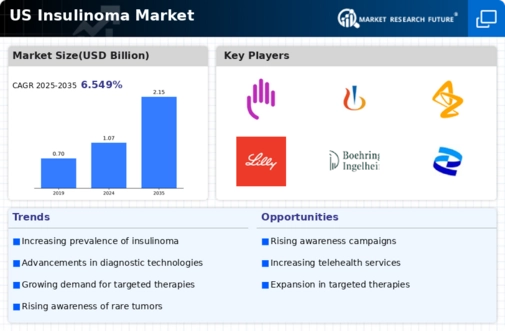Growing Incidence of Insulinoma Cases
The rising incidence of insulinoma cases in the US is a pivotal driver for the insulinoma market. Recent data indicates that the annual incidence of insulinoma is approximately 4 cases per million people, which translates to around 1,200 new cases each year in the US. This increasing prevalence necessitates enhanced diagnostic and therapeutic options, thereby propelling market growth. As awareness of insulinoma symptoms improves among healthcare professionals and patients, earlier diagnosis is likely, leading to increased demand for treatment options. The insulinoma market is expected to expand as healthcare providers seek effective solutions to manage this rare but serious condition, ultimately contributing to a more robust healthcare framework for affected individuals.
Regulatory Support for Drug Approvals
Regulatory support for drug approvals is an essential driver for the insulinoma market. The US Food and Drug Administration (FDA) has been increasingly supportive of expedited review processes for drugs targeting rare diseases, including insulinoma. This regulatory environment encourages pharmaceutical companies to invest in the development of new therapies, as the likelihood of successful approval appears higher. In recent years, several drugs have received orphan drug designation, which provides incentives for manufacturers. As a result, the insulinoma market is likely to experience growth as new treatment options become available, ultimately benefiting patients with this rare condition.
Rising Investment in Oncology Research
Rising investment in oncology research is a significant factor impacting the insulinoma market. The US government and private sectors are increasingly allocating funds towards cancer research, including rare tumors like insulinoma. In 2025, it is estimated that funding for cancer research will exceed $6 billion, with a portion dedicated to understanding insulinoma's pathophysiology and treatment. This influx of research funding is likely to accelerate the development of novel therapies and diagnostic tools, thereby enhancing the overall market landscape. As research progresses, the insulinoma market may witness the introduction of innovative solutions that improve patient care and outcomes.
Increased Awareness and Education Initiatives
Increased awareness and education initiatives regarding insulinoma are crucial drivers for the insulinoma market. Various organizations and healthcare providers are actively working to educate both the public and medical professionals about the signs and symptoms of insulinoma. This heightened awareness is likely to lead to earlier diagnosis and treatment, which is essential for improving patient outcomes. Additionally, educational campaigns may encourage more patients to seek medical attention, thereby increasing the number of diagnosed cases. As awareness grows, the insulinoma market is expected to expand, with a corresponding rise in demand for diagnostic tools and treatment options.
Technological Innovations in Treatment Modalities
Technological advancements in treatment modalities are significantly influencing the insulinoma market. Innovations such as minimally invasive surgical techniques and targeted therapies are becoming more prevalent, enhancing patient outcomes and recovery times. For instance, laparoscopic surgery has shown to reduce hospital stays and postoperative complications, making it a preferred option for many patients. Furthermore, the introduction of novel pharmacological agents that target insulin secretion is likely to reshape treatment paradigms. As these technologies evolve, they may lead to increased adoption rates among healthcare providers, thereby driving market growth. The insulinoma market stands to benefit from these advancements, as they offer new avenues for effective management of the disease.

















Leave a Comment